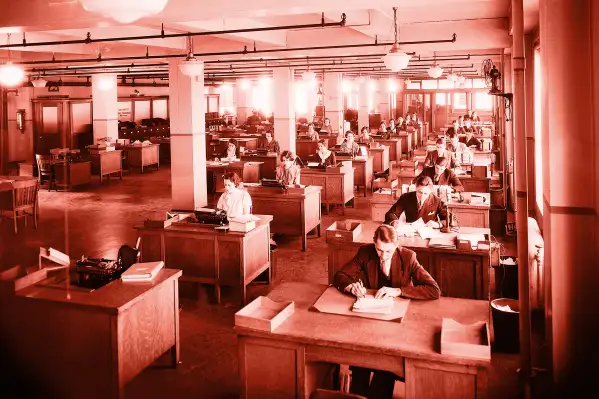Workplaces Are More Segregated Than 40 Years Ago. What Gives?

Companies have long trumpeted sweeping diversity initiatives, but even in era of “Chief People Officers” and “transparent company cultures,” a growing body of research shows that workplace racial segregation is greater today than it was a generation ago.
Sociologists from Stanford University and Harvard Business School recently looked at more than 40 years of data on the racial makeup of every large private-sector workplace in the U.S., and found that while there are more people of color across occupations, individual employers are still pretty homogenous and actually more divided than they were in the '70s.
“In terms of integrating workplaces, employers are making less progress than we thought they were,” says John-Paul Ferguson, PhD, one of the lead researchers.
What gives?
Our perceptions of diversity are partially to blame, he says.
Most workers, particularly the white ones, are operating under the baseline assumption that companies, while not perfectly impervious to racial bias, have made measurable strides in ramping up diversity over the last several decades.
It’s a reasonable position to take: after all, our country is certainly becoming more diverse as a whole. In 2016, the U.S. population was about 61% white, compared to 76% in 1990, and 81% in 1975, according to Census Bureau estimates.
But while almost everyone knows non-white sales reps, marketing directors, and every other type of professional in today’s workforce, there are still more non-white workers in low-wage janitorial, kitchen, and service roles that each office relies on. And since a wave of outsourcing has led entire industries to tap outside contractors to fill these jobs, many of the employees who take them aren’t even on the same payroll as the people whose desks they clean, meals they serve, and packages they deliver.
It’s diversity with an asterisk. And what's worse, new companies don’t seem to be better at attracting, retaining and promoting people of color than their predecessors were, according to Ferguson.
“If everyone in the mail room is black, and all the white people are computer programmers, it doesn’t matter if the labor force as a whole is a lot more diverse,” he says.
The implications are hard to ignore. For companies, this persistent lack of representation leads to a scarcity of the ideas, backgrounds, and experiences every employer claims to value.
For individuals, this divide quietly manifests into every facet of workplace policy — from hiring bias that makes it less likely for people with “black sounding names” to get an interview, to workplace dress codes that ban natural hairstyles. Most troubling, though, is the growing racial pay gap that points to the average black man earning just 70% of what a white man makes, and the average black woman earning 82% of a white woman’s paycheck.
For what it’s worth, companies seem to want to be inclusive. In a February survey from Deloitte, 69% of CEOs said they consider diversity to be an important issue. And there are more corporate diversity trainings, inclusion initiatives, and tech-based hiring solutions than ever before.
For white workers, this probably look like progress. But so far, there’s no proof that any of these things do more than add another box for HR departments to check off their to-do list.
Unconscious bias training, the courses many Fortune 500 companies use to help employees alter their assumptions about race, has as many critics as it does supporters. And the new solution du jour, “algorithmic hiring,” a favorite tool of recruitment platforms that claim to negate application bias by taking humans out of the process, also has its shortcomings.
“Algorithms are helping to get a broader set of resumes in front of the hiring manager, without question,” says Erica Volini, Deloitte’s Human Capital Leader. “But if you don’t have managers who are still thinking on a more inclusive basis, the technology can only get you so far.”
Today, a handful of companies are working out how to do this type of hiring without any human interaction at all. No humans, no bias, right?
Tilr, a Cincinnati-based startup that launched in 2016, places vetted job seekers directly into open gigs based on their skills, without any interview or phone screen. In its current form, the platform is mostly used for temp roles, with some companies agreeing to let Tilr pick permanent hires after they’ve seen the algorithm at work.
Carisa Miklusak, Tilr’s CEO, says the company plans to roll out a beta version for traditional, full-time positions in late 2018 or early 2019. By then, she hopes, employers will learn to trust the same sort of technology that matches Uber drivers and riders to find their next employee.
“There’s a trust curve, but like telemedicine, where algorithms are matching people with doctors, it’s just a matter of acceptance and proof,” she says.
Jopwell, another new entrant to the recruiting space, partners with large companies like Pinterest, UBS, and the New York Times to match open jobs with black, Latino/Hispanic, and Native American job seekers. Jopwell’s executives claim companies who use their platform see hiring yields up to 20 times higher than their broader applicant pools.
Will any of these efforts translate to a more integrated office? Maybe.
But even the companies behind them, and those whose success hinges on a more diverse workforce, admit we've got a long way to go.
“This isn’t an overnight fix,” says Ryan Williams, cofounder of Jopwell. “But the fact that companies are recognizing that some individuals don’t have a seat at the table is a good thing.”
